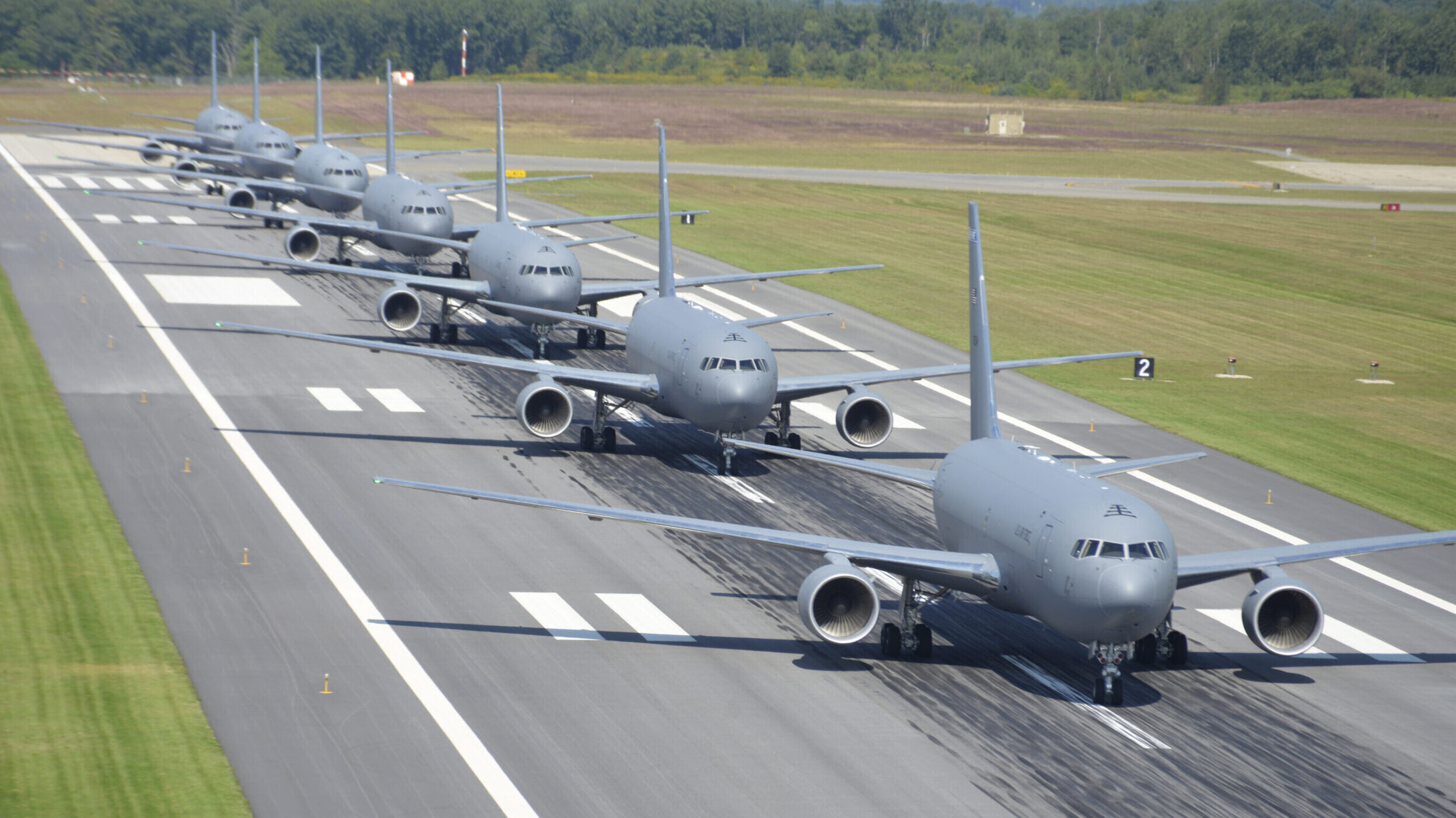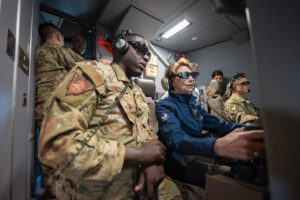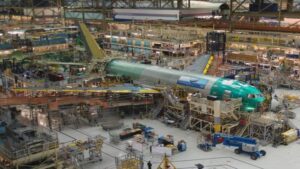
KC-46A aircraft assigned to the 157th Air Refueling Wing perform an elephant walk formation on the runway at Pease Air National Guard Base, Sept. 8, 2021. (US Air National Guard/Senior Master Sgt. Timm Huffman)
WASHINGTON: Weeks after the Air Force issued a statement claiming that Boeing would pay for changes to the KC-46 tanker’s panoramic suite, the service has reversed course and now says the Air Force itself will pony up the cash for new panoramic sensors — a major and potentially costly element of the fix.
Meanwhile, service officials remain seemingly unable to lay out how much the repair will cost taxpayers to allow the tanker to do its one key job: refueling American jets mid-flight.
On April 11, the Air Force officially closed the preliminary design review for the KC-46’s Remote Vision System 2.0 after striking a deal with Boeing on a fix for the panoramic suite.
When Breaking Defense first reported the agreement on April 19, the Air Force stated on the record that Boeing would be responsible for paying for all elements of the RVS fix, including upgrades to the panoramic system used to detect and identify aircraft approaching the tanker for fuel.
However, the service now says the initial statements provided to Breaking Defense inaccurately portrayed the nature of the agreement on the panoramic suite fix, and that taxpayers are, in fact, on the hook for associated costs.
Under the terms of the KC-46’s fixed price development contract, Boeing is held financially responsible for resolving all problems that exceed the contract’s $4.9 billion ceiling, including longstanding technical issues with the Remote Vision System used to steer the tanker’s refueling boom into an aircraft needing gas.
The company has struggled to keep the KC-46 program on cost and on schedule. The tanker won’t be declared operational until around 2024 due to continued technical problems. At the same time, Boeing has racked up more than $5 billion in extra costs.
While the initial contract has largely protected In taxpayers from those cost impacts, in December 2020, the Air Force finalized an RVS 2.0 system architecture that called for no changes to the panoramic sensors — a move that may have precluded the Air Force from being able to force Boeing to pay for upgrades to the panoramic suite.
At the time, Boeing and the Air Force believed a new “image processing approach” could fix longstanding issues with the panoramic system’s performance and that there would be “minimal performance improvement” if the panoramic sensors were upgraded without modifying the displays, said Air Force spokeswoman Capt. Samantha Morrison said in a May 2 statement. (For this story, Breaking Defense relied on Air Force statements in response to written questions, dated April 20, April 22, May 2 and May 3.)

Staff Sgt. Devaughn Granger shows former Secretary of the Air Force Barbara Barrett the functionality of the KC-46A Pegasus boom June 10, 2020, above Kansas. (US Air Force/Staff Sgt. Chris Thornbury)
However, operators found the image processing fix to be “insufficient,” and the panoramic system presented as part of the preliminary design review “did not adequately address the shortfall in panoramic imagery performance,” she said.
Ultimately, the Air Force and Boeing negotiated a “cost-sharing approach” to upgrading panoramic system after they determined new sensors could provide boom operators inside the KC-46 with improved imagery even if the displays inside the tanker were not upgraded.
While Boeing will pay to develop the new sensors, the service will foot the bill to buy the individual electro-optical and infrared cameras for the panoramic suite. Boeing will also pay for “provisioning” costs such as “wiring [and] processing hardware” that ties the panoramic sensors to the wider vision system, Morrison said.
Ultimately, the Air Force’s share of the cost for the fix is currently unknown, she said.
“Initial design work on the upgraded system only began once the USAF-Boeing agreement was made; therefore a detailed understanding of the supplier’s costs is not yet available,” Morrison said.
Boeing declined to comment on its exact role in funding the panoramic display upgrades, saying only that the changes would allow the tanker “to evolve for the future with capabilities that did at exist at the time the contract was initially signed” and that “generations of service members will benefit from these improved capabilities.”
Understanding The KC-46’s Panoramic Display System
The refueling process in a KC-46 breaks from tradition. In legacy aerial refueling tankers like the KC-10 and KC-135, boom operators looked out a window at the back of the tanker, were visually able to see an aircraft approach the tanker and then manually steered a boom into a receiver aircraft before offloading fuel.
In contrast, boom operators in the KC-46 sit at a station behind the cockpit, relying on a series of cameras and sensors to provide real time, accurate video imagery that allows them to see an approaching aircraft and refuel it. Those include the Remote Vision System — which allows operators to see the position of the refueling boom — and the panoramic sensor suite, which provides imagery of incoming aircraft.
The Air Force has identified two critical technical issues associated with the RVS. First, it does not provide imagery with the visual clarity boom operators need to refuel other aircraft in all weather and lighting conditions. Those issues contribute to a second problem: an increased risk of the boom scraping against the receiver aircraft during the refueling process. Boeing agreed to replace the old Remote Vision System with a new “RVS 2.0” in 2020.
However, the panoramic sensor system has also been a source of technical problems, as it does not meet the specification to detect and identify aircraft at required ranges in all weather and lighting conditions, a defense official with knowledge of the program previously told Breaking Defense.

KC-46 under construction at Boeing’s factory. (Boeing)
The KC-46’s panoramic sensor suite comprises three line replaceable units, or LRUs, which provide video to three panoramic displays used by boom operators to see aircraft flying towards the KC-46. Currently, each LRU has a single long wave infrared camera. The upgraded panoramic suite will add a electro-optical camera to each LRU as well as replace the existing infrared sensor with the same, more modern system that will be used as part of the Remote Vision System, Morrison said.
“The Air Force will purchase the new panoramic sensors to support fleet retrofit and to provide to Boeing, as Government Furnished Equipment, in support of production,” she said. “While the panoramic displays will remain the same, the improved panoramic sensors and the ability to display panoramic imagery on the upgraded primary display will result in significant improvements in capabilities.”
If the upgrades to RVS 2.0 or the panoramic sensor suite do not end up having the intended effect, the Air Force will be responsible for paying for future modifications to the system, as the RVS 2.0 design approved last month is now considered the official design specification for the system.
However, the Air Force believes “the approved RVS 2.0 design, to include the panoramic sensor upgrades, provides the lowest technical risk toward meeting all requirements and resolving deficiencies,” Morrison said.
The Air Force intends to buy 179 KC-46s over its program of record but could end up buying dozens more. The service is currently assessing whether to hold a competition — known interchangeably as KC-Y or Bridge Tanker — to buy anywhere from 140 to 160 new tankers to replace the KC-10 and KC-135.
However, Air Force Secretary Frank Kendall has said that the service could just opt to buy additional KC-46s without opening up a competition.
“I’m trying to be as transparent and honest about this as I can be. It is not as certain as it was a year ago, let’s say, that we’re going to do a competition,” Kendall told lawmakers last week at a House Armed Services Committee hearing. “And I don’t want people to have a misimpression about that. [But] we have not made a final decision yet.”
Kendall said that, despite longstanding technical issues, the KC-46’s performance is improving and that there may not be sufficient demand for another tanker variant.
Ultimately, that would be bad news for Lockheed Martin, which plans to propose its LMXT tanker, a version of the Airbus 330 Multi-Role Tanker Transport, if a KC-Y competition is announced.
Sullivan: Defense industry ‘still underestimating’ global need for munitions
National Security Advisor Jake Sullivan said that there are “no plans” for another Ukraine supplemental at this point.


























